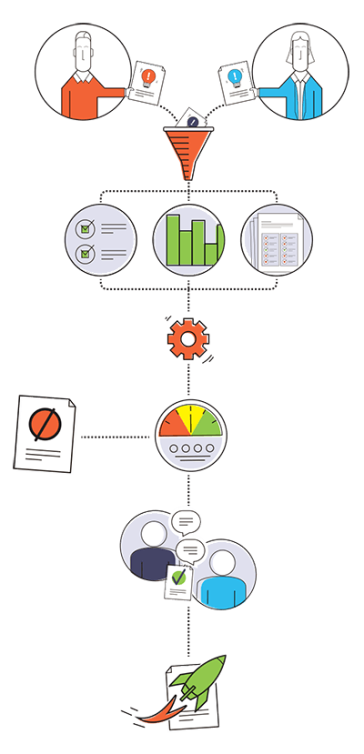An Approach to Innovation with Process Automation
By Mike Raia ![]() | Published February 6, 2018
| Published February 6, 2018
Innovation comes from a sustained, concerted effort by all employees to identify and improve how they work together and get things done.
Where Innovation Comes From

Innovating a business means a cultural shift toward thinking, "How can we get better?" When you instill this mentality in all employees, your organization can see immediate and ongoing improvement in its operations. Employees begin to find opportunities for improvement everywhere, from how they process invoices to how they interact with coworkers daily. A holistic approach to improving processes across the organization, with all employees involved, can also avoid the trap of focusing only on operational processes (customer-facing) rather than including equally critical administrative processes.
How Did We Get Here?
The reality is that your processes have likely grown organically rather than resulting from a concerted, thoughtful effort toward efficiency. It's not that these processes were designed poorly so much as they weren't "designed" at all. Instead, many of your processes may have come from knee-jerk reactions, band-aids, and half-hearted improvement efforts.
The results can be significant and contagious when employees are encouraged to challenge the status quo and offer better solutions (instead of merely challenging everything without offering an alternative). When the goal is to improve quality, cut costs, reduce cycle times, and improve operating performance, business processes are often ripe for rethinking. Commonly, this rethinking involves process automation.
When evaluating a process, ideas may follow two different narratives. In one narrative, the process is completely re-engineered, meaning nothing is taken for granted and no workflows or tasks are necessarily retained. In the other narrative, the goal is to keep the inherent structure of the process while looking for opportunities to improve it (reducing hand-offs, adding quality gates, etc.)
Approaching Your Processes with Fresh Eyes
In that spirit, I'd ask you to step back and consider your current processes. If they're not all already documented, take some time to do so. For clarity, use this handy definition of "a process:"
"A process is thus a specific ordering of work activities across time and place, with a beginning, an end, and clearly defined inputs and outputs: a structure for action.”
T.H. Davenport, Process Innovation (Boston: Harvard Business School Press, 1993), p. 5.
You will discover most of your processes fall into a few different buckets:
- Interdepartmental: The entire process occurs within one department.
- Multidepartmental: The process involves several different departments.
- Organization-wide: The process could involve any employee in the organization.
- Customer-Facing: The process involves interactions between employees and existing customers.
- Public-Facing: Similar to Customer-Facing, the process could involve any public member, whether a current customer, potential customer, or citizen (governmental process).
Your ability to affect change in any of these processes could be limited depending on your role in the organization. You can focus on the areas within your sphere of control or, additionally, you can make suggestions for process improvements in other areas of the organization to the appropriate stakeholders.
However, to make immediate improvements, you'll need to start with the processes by which you can affect change. You're looking for process bottlenecks and task overlaps that can be removed or alleviated.
One Approach
Here's one way to approach your existing processes and begin to find areas of improvement:
- Identify a process you believe you can improve with automation each month or quarter.
- Map out the current process in whatever process illustration tool you prefer (Visio, Gliphy, SmartDraw, etc.) and decide how the performance of the process should be tracked.
- Map out the future state of the process with your suggested improvements and decide on success measures (improve quality, cut costs, reduce cycle times, etc.)
- Socialize the new process with as many stakeholders as possible and make the appropriate alterations.
- Build the process in your process automation solution (we make one, check it out here).
- Test the process and make alterations.
- Invite stakeholders to walk through the new process and provide feedback. Make alterations based on the feedback.
- Roll out the new automated process (depending on the scale of the process, this can be done formally or informally.)
- Plan to make more edits as the process is used in the wild and you track success.

Mike Raia
Marketing the world's best workflow automation software and drinking way too much coffee. Connect with me on LinkedIn at https://www.linkedin.com/in/michaelraia/